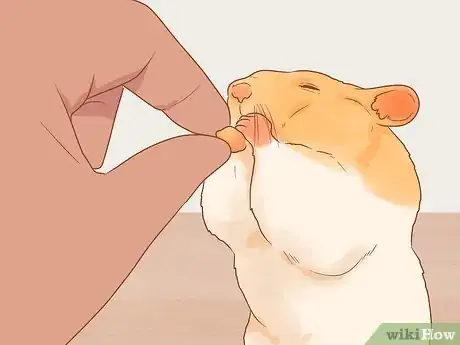This article was co-authored by Pippa Elliott, MRCVS. Dr. Elliott, BVMS, MRCVS is a veterinarian with over 30 years of experience in veterinary surgery and companion animal practice. She graduated from the University of Glasgow in 1987 with a degree in veterinary medicine and surgery. She has worked at the same animal clinic in her hometown for over 20 years.
This article has been viewed 33,583 times.
Deciding between a Syrian or dwarf hamster can be tricky. Hamster owners often debate which breed is better, since each has its own pros and cons. When choosing between the two, you should keep in mind your experience raising hamsters, differences in the characteristics of the two breeds, and your family and home situation. Knowing the key differences between the two will allow you to decide which hamster breed is best suited for you and your home.
Steps
Choosing Based on Size and Appearance
-
1Get a Syrian hamster if you’d like a larger hamster. Syrian hamsters are much larger than dwarf hamsters, growing to be as long as 6–7 inches (15–18 cm). Because Syrian hamsters are larger, you’ll need a little more space to take care of one than you would with a dwarf hamster, since it will need a more spacious cage and a larger hamster wheel.[1]
- To house Syrian hamsters, you’ll want to prepare a large wire cage with a plastic base.
- A cage for a Syrian hamster should have a base no smaller than 60 cm × 30 cm (24 in × 12 in), and it should be at least 30 centimetres (12 in) tall.
-
2Opt for a dwarf hamster if you’d like a smaller hamster. Dwarf hamsters, on the other hand, grow to only around 3–5 inches (7.6–12.7 cm). The small size of dwarf hamsters can make it a little more difficult to keep track of them, as they can squeeze through small spaces and hide in tiny nooks and crannies.[2]
- Because of their small size and ability to squeeze through small spaces, it is best to keep dwarf hamsters in a tank or aquarium rather than a wire cage.
- You’ll want to use a wire lid for the tank to allow for ventilation.
Advertisement -
3Select a Syrian hamster if you’d like one that looks like a teddy bear. The Syrian hamster is also called the teddy bear hamster because of its resemblance to the adorable stuffed animal. Most Syrian hamsters have golden brown fur, white bellies, and large, round black eyes.[3]
- While most Syrian hamsters are golden brown in color, you can also find ones with white, black, brown, or gray coats.
-
4Elect for a dwarf hamster if you’d like one with a mouse-like appearance. Dwarf hamsters have a natural grey-brown coloration with a white belly. Compared to the Syrian hamster, dwarf hamsters have more mouse-like facial features, complete with teensy, beady eyes.[4]
- While most dwarf hamsters are grey-brown in color, you can also find them in a range of other colors.
Comparing the Hamsters’ Personalities
-
1Choose a Syrian hamster if you have small children. Syrian hamsters are the friendlier of the two hamster breeds. They have sweet personalities, are easy to handle, and rarely bite. Dwarf hamsters, meanwhile, are more easily startled and are more prone to nip. If you have small children, getting a Syrian hamster is probably the better choice.[5]
- Although easy to handle, Syrian hamsters will, of course, nip if handled roughly, startled, or disturbed while sleeping.
- Always keep an eye on young children when they are handling a hamster.
-
2Go with dwarf hamsters if you’d like to keep more than 1. If you want to keep more than one hamster, on the other hand, Syrian hamsters are definitely not an option. They are very territorial and will fight over space. These fights can be fatal. Two or more dwarf hamsters, however, can be kept in the same cage, if they are all the same sex.[6]
- If you choose to keep two or more dwarf hamsters in one cage, keep an eye on them to make sure that they get along well. Not all dwarf hamsters enjoy the company of others.
- Males are more likely to fight with one another than females.
-
3Get to know your hamster before choosing. Despite the general characteristics of the two types of hamster, each hamster has its own unique personality. Handling a specific hamster will tell you the most about its personality.
- You’ll want to look for a hamster that seems lively, inquisitive, and in good health.
- If a hamster is shaking or quick to bite, it may not be a good choice, as it will likely be more difficult to tame.
- Before picking up a hamster, let it smell your fingers. If it appears calm and relaxed, gently scoop it up with both hands. You’ll want to talk to it in a gentle voice and move slowly throughout.[7]
References
- ↑ https://www.bluecross.org.uk/pet-advice/looking-after-hamster
- ↑ https://www.bluecross.org.uk/pet-advice/looking-after-hamster
- ↑ https://squeaksandnibbles.com/hamster-breeds/
- ↑ https://squeaksandnibbles.com/hamster-breeds/
- ↑ https://squeaksandnibbles.com/hamster-breeds/
- ↑ https://www.bluecross.org.uk/pet-advice/looking-after-hamster/
- ↑ http://hamsterific.com/hamster-care/handling-hamster/


































































